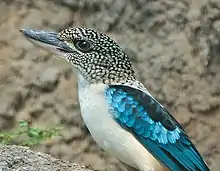Kookaburra
Kookaburras (pronounced /ˈkukəbʌrə/)[3] are terrestrial tree kingfishers of the genus Dacelo native to Australia and New Guinea, which grow to between 28 and 47 cm (11 and 19 in) in length and weigh around 300 g (11 oz). The name is a loanword from Wiradjuri guuguubarra, onomatopoeic of its call. The loud, distinctive call of the laughing kookaburra is widely used as a stock sound effect in situations that involve an Australian bush setting or tropical jungle, especially in older movies.
| Kookaburra | |
|---|---|
 | |
| Laughing Kookaburra in Tasmania, Australia | |
| Scientific classification | |
| Domain: | Eukaryota |
| Kingdom: | Animalia |
| Phylum: | Chordata |
| Clade: | Dinosauria |
| Class: | Aves |
| Order: | Coraciiformes |
| Family: | Alcedinidae |
| Subfamily: | Halcyoninae |
| Genus: | Dacelo Leach, 1815 |
| Type species | |
| Alcedo gigantea[1] Hermann, 1783 | |
| Species | |
| Phylogeny | |||||||||||||||||||||||||||
| |||||||||||||||||||||||||||
| Cladogram based on the molecular analysis by Andersen and colleagues published in 2017.[2] |
They are found in habitats ranging from humid forest to arid savannah, as well as in suburban areas with tall trees or near running water. Though they belong to the larger group known as "kingfishers", kookaburras are not closely associated with water.[4]
Taxonomy
The genus Dacelo was introduced by English zoologist William Elford Leach in 1815.[5] The type species is the laughing kookaburra.[1] The name Dacelo is an anagram of alcedo, the Latin word for a kingfisher.[6] A molecular study published in 2017 found that the genus Dacelo, as then defined, was paraphyletic. The shovel-billed kookaburra was previously classified in the monotypic genus Clytoceyx, but was reclassified into Dacelo based on phylogenetic evidence.[2]
Classification and species
Five species of kookaburra can be found in Australia, New Guinea, and the Aru Islands:[7]
- Shovel-billed kookaburra (Dacelo rex) – upland New Guinea
- Spangled kookaburra (Dacelo tyro) – Aru Islands, southern New Guinea
- Rufous-bellied kookaburra (Dacelo gaudichaud) – lowland New Guinea
- Laughing kookaburra (Dacelo novaeguineae) – native to eastern Australia, introduced to southwest
- Blue-winged kookaburra (Dacelo leachii) – northern Australia, southern New Guinea
Unusually for close relatives, the laughing and blue-winged species are direct competitors in the area where their ranges now overlap.[8] This suggests that these two species evolved in isolation, possibly during a period when Australia and New Guinea were more distant.
Kookaburras are sexually dimorphic. This is noticeable in the blue-winged and the rufous-bellied, where males have blue tails and females have reddish-brown tails.
Behaviour
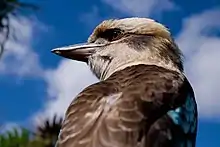
Kookaburras are almost exclusively carnivorous, eating mice, snakes, insects, small reptiles, and the young of other birds. Unlike many other kingfishers, they rarely eat fish, although they have been known to take goldfish from garden ponds. In zoos, they are usually fed food suitable for birds of prey.
Although most birds will accept handouts and take meat from barbecues, feeding kookaburras ground beef or pet food is not advised, because they do not include enough calcium and roughage.[9]
They are territorial, except for the rufous-bellied, which often live with their young from the previous season.[10] They often sing as a chorus to mark their territory.
Conservation
All kookaburra species are listed as least concern. Australian law protects native birds, including kookaburras.[11]
In popular culture
The distinctive sound of the laughing kookaburra's call resembles human laughter, is widely used in filmmaking and television productions, as well as certain Disney theme-park attractions, regardless of African, Asian, or South American jungle settings. Kookaburras have also appeared in several video games, including (Lineage II, Battletoads, and World of Warcraft). The children's television series Splatalot! includes an Australian character called "Kookaburra" (or "Kook"), whose costume includes decorative wings that recall the bird's plumage, and who is noted for his distinctive, high-pitched laugh. Olly the Kookaburra was one of the three mascots chosen for the 2000 Summer Olympics in Sydney. The other mascots were Millie the Echidna and Syd the Platypus. The call of a kookaburra nicknamed "Jacko" was for many years used as the morning opening theme by ABC radio stations, and for Radio Australia's overseas broadcasts.[12]
Book
- The opening theme from ABC was the basis for a children's book by Brooke Nicholls titled Jacko, the Broadcasting Kookaburra — His Life and Adventures.[13][12]
- In William Arden's 1969 book, The Mystery of the Laughing Shadow (one of the Three Investigators series for young readers), the laughing kookaburra is integral to the plot.[14]
- In the short story (Barry Wood's "Nowhere to Go").
Film
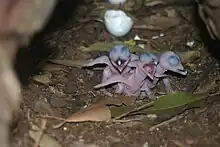
- Heard in some of the early Johnny Weissmuller films, the first occurrence was in Tarzan and the Green Goddess (1938).[15]
- The call is heard in The Wizard of Oz (1939), The Treasure of the Sierra Madre (1948), Swiss Family Robinson (1960), Cape Fear (1962), The Lost World: Jurassic Park, and other films.[16]
- The dolphin call in the television series Flipper (1964-7) is a modified kookaburra call.[17]
- The call is imitated perfectly by the character Billy (David Gulpilil) in the Australian film Mad Dog Morgan (1976).
- The call can be heard at the beginning of Raiders of the Lost Ark (1981) in the jungle scene.
- The call can be heard in the Australian film True History of the Kelly Gang (2019) when Constable Fitzpatrick is investigating the first killings by the newly formed Kelly Gang.
- The overarching antagonist of Koala Man (2023) is a character named Christopher, who later takes on the identity of "The Kookaburra". Voiced by Jemaine Clement, he is the titular character's former friend turned archnemesis and often makes calls similar to the bird.
Music
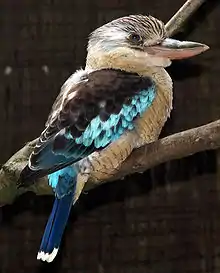
- "Kookaburra [sits in the old gum tree]", a well-known children's song, was written in 1932 by Marion Sinclair.
- "Kookaburra" by Cocteau Twins was released on their 1985 EP Aikea-Guinea.
- "Kookaburra" by John Vanderslice is on his 2007 album Emerald City.
- The Kookaburras are an English band from County Durham.
- The lyric "... the Laughing Kookaburras call ..." appears in the song "Across the Hills of Home" on the album Something of Value by Eric Bogle.
- BFD Records and BFD Productions, which are the distributors and/or copyright holders of most of the garage rock and psychedelic rock compilation albums in the Pebbles series, have the address Kookaburra, Australia.
- "Well the kookaburra laughed ..." appeared in the song "Old Man Emu" by John Williamson.
- Australian band King Gizzard and the Lizard Wizard features the kookaburra's call in their songs "Doom City" from the album Flying Microtonal Banana and "All Is Known" from the album Gumboot Soup, both released in 2017.
Postage stamps
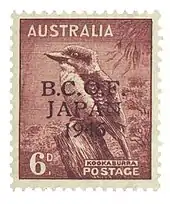
- A six-pence stamp was issued in 1914.
- A three-pence commemorative Australian stamp was issued for the 1928 Melbourne International Philatelic Exhibition.
- A six-pence stamp was issued in 1932.
- A 38¢ Australian stamp issued in 1990 features a pair of kookaburras.[18]
- An international $1.70 Australian stamp featuring an illustrated kookaburra was released in 2013.
- A $1.10 laughing kookaburra stamp issued in 2020
Money

- An Australian coin known as the Silver Kookaburra has been minted annually since 1990.[19]
- The kookaburra is featured multiple times on the Australian twenty-dollar note.
Usage across sport
- The Australian 12-m yacht Kookaburra III lost the America's Cup in 1987.[20]
- The Australia men's national field hockey team is named after the kookaburra. They were world champions in field hockey in 1986, 2010 and 2014.[21]
- Australian sports equipment company Kookaburra Sport is named after the bird.
References
- Peters, James Lee, ed. (1945). Check-list of Birds of the World. Volume 5. Vol. 5. Cambridge, Massachusetts: Harvard University Press. p. 189.
- Andersen, M.J.; McCullough, J.M.; Mauck III, W.M.; Smith, B.T.; Moyle, R.G. (2017). "A phylogeny of kingfishers reveals an Indomalayan origin and elevated rates of diversification on oceanic islands". Journal of Biogeography. 45 (2): 1–13. doi:10.1111/jbi.13139.
- Wells, John C. (2000). Longman Pronunciation Dictionary (2nd ed.). Longman. p. 423. ISBN 0-582-36467-1.
- Simpson, Ken (1989). Field guide to the birds of Australia: a book of identification. Christopher Helm. p. 317.
- Leach’s, William Elford (1815). The Zoological Miscellany; being descriptions of new, or interesting Animals. Vol. 2. London: B. McMillan for E. Nodder & Son. p. 125.
- Jobling, James A. (2010). The of Scientific Bird Names. London: Christopher Helm. p. 130. ISBN 978-1-4081-2501-4.
- "Rollers, ground rollers, kingfishers – IOC World Bird List". www.worldbirdnames.org. Retrieved 2023-02-03.
- "Kookaburra, Dacelo sp. Factsheet (Bibliography)". San Diego Zoo. Archived from the original on 2 February 2017. Retrieved 23 Jan 2017.
- Giles, Jennie (1994). "Caring for Wild Birds in Captivity Series (Adelaide and Environs): Caring for Kookaburras" (PDF). Bird Care & Conservation Society South Australia Inc. Archived from the original (PDF) on 29 May 2015. Retrieved 26 August 2015.
- Legge, Sarah (2004). Kookaburra: King of the Bush. Collingwood, Victoria: CSIRO Publishing. ISBN 978-0-643-09063-7. OCLC 223994691.
- "BirdLife Data Zone". datazone.birdlife.org. Retrieved 2022-05-03.
- Jerry Berg. "Jacko, the Broadcasting Kookaburra". Retrieved 3 June 2017.
- Nicholls, Brooke (1933). Jacko, the Broadcasting Kookaburra — His Life and Adventures. Angus & Robertson.
- "The Mystery of the Laughing Shadow". Archived from the original on 30 July 2001.
{{cite web}}: CS1 maint: unfit URL (link) - Melissa (2013-08-27). "Of Tarzan and Kookaburras". The Sound and the Foley. Retrieved 2023-02-07.
- Melissa (2013-05-30). "That Jungle Sound". The Sound and the Foley. Retrieved 2023-02-07.
- Arthur, Nicole (2003-01-31). "Day of the Dolphin". Washington Post. ISSN 0190-8286. Retrieved 2023-02-07.
- "Birds on stamps: Australia Australië Australie". www.birdtheme.org. Retrieved 2023-02-07.
- "Australian Kookaburra". Silver Bullion World. Retrieved 4 November 2013.
- "Maritime Topics On Stamps, America Cup, Sailing". Archived from the original on 2008-06-08. Retrieved 2008-06-14.
- "Kookaburras (men)". 2014-06-26. Archived from the original on 2014-06-26. Retrieved 2023-02-07.
Bibliography
Brooke Nicholls; Dorothy Wall (illus.) (1933). Jacko, the Broadcasting Kookaburra — His Life and Adventures. Sydney: Angus & Robertson.
Further reading
- Kookaburra sketches and calls at the Australian National Botanic Gardens site. Archived from the original on 2008-07-20. Retrieved 2010-09-03.
